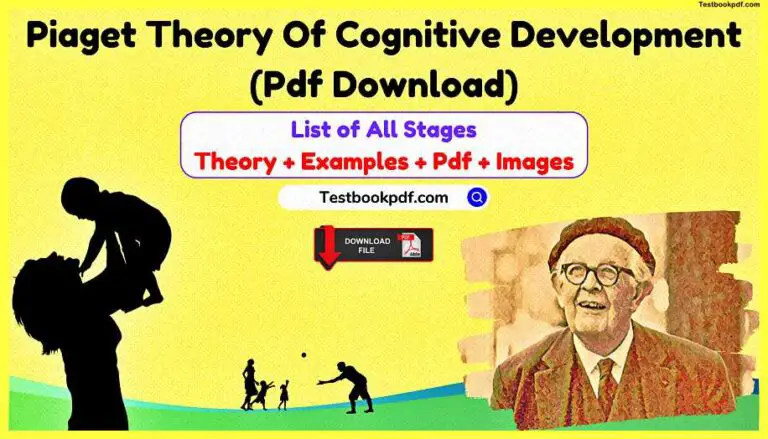Piaget Theory Of Cognitive Development Pdf Download
Today in this article we will talk about the Piaget Theory Of Cognitive Development Pdf Download with Examples, Images and you can Download this Page as a Pdf in One Click just go to the End of this article and press the Button ( ).
Jean Piaget (1896 – 1980 ): History
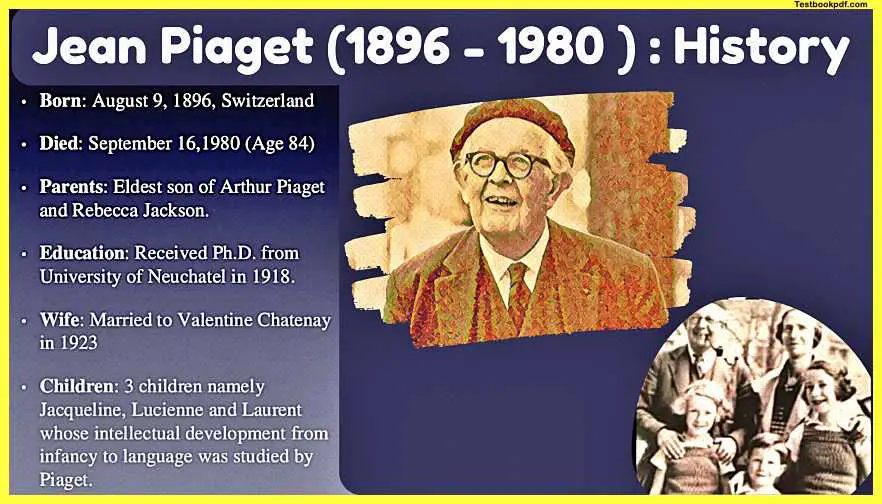
- Jean Piaget Born: August 9, 1896, Switzerland
- Jean Piaget Died: September 16, 1980 (Age 84)
- Jean Piaget’s Parents: Eldest son of Arthur Piaget and Rebecca Jackson.
- Jean Piaget’s Education: Received a Ph.D. from the University of Neuchatel in 1918.
- Valentine Chatenay and Jean Piaget were wed in 1923.
- Children of Jean Piaget: Piaget investigated the intellectual growth of three children, Jacqueline, Lucienne, and Laurent, from infancy through language.
Jean Piaget Introduction
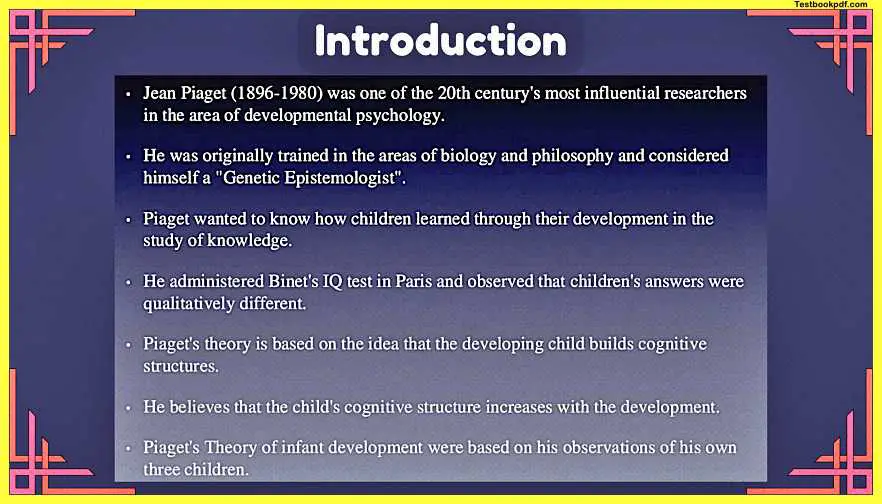
- In the field of developmental psychology, Jean Piaget (1896–1981) was one of the most significant researchers of the 20th century.
- Initially educated in biology and philosophy, Jean Piaget referred to himself as a “Genetic Epistemologist.”
- Jean Piaget was interested in how children learned via the study of knowledge as they developed.
- When Jean Piaget offered the IQ test to children in Paris, he saw that the results were qualitatively different from those of adults. The foundation of Piaget’s theory is the notion that a kid develops cognitive structures.
- According to Jean Piaget, a child’s cognitive structure develops throughout time.
- Based on his observations of his own three children, Jean Piaget Piaget developed his theory of baby development.
What is Cognitive Development?
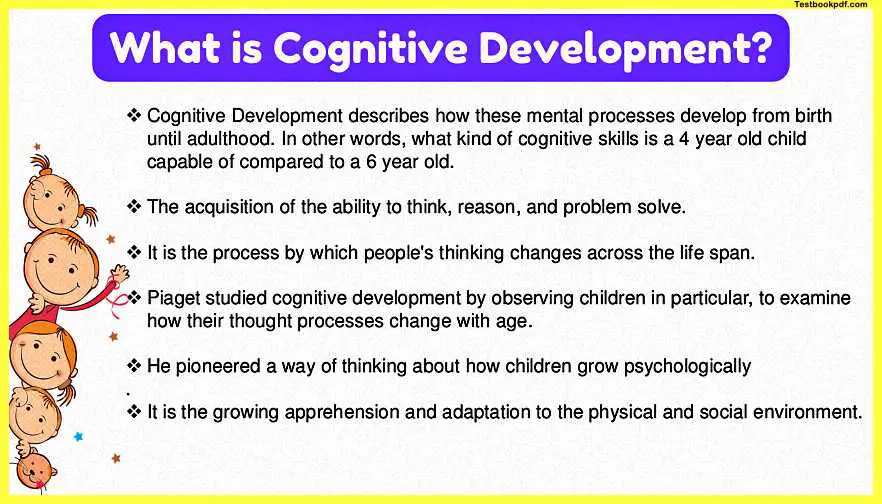
- From birth through adulthood, these mental functions evolve according to a concept known as cognitive development. Or, how different are a child’s cognitive abilities at age 4 and age 6 respectively.
- The acquisition of the ability to think, reason, and problem solve.
- It is the process by which people’s thinking changes across the lifespan.
- Piaget focused on studying youngsters to better understand how the development of their thought processes over time.
- He pioneered a way of thinking about how children grow psychologically
- It is the growing apprehension and adaptation to the physical and social environment.
Theory of Cognition Development
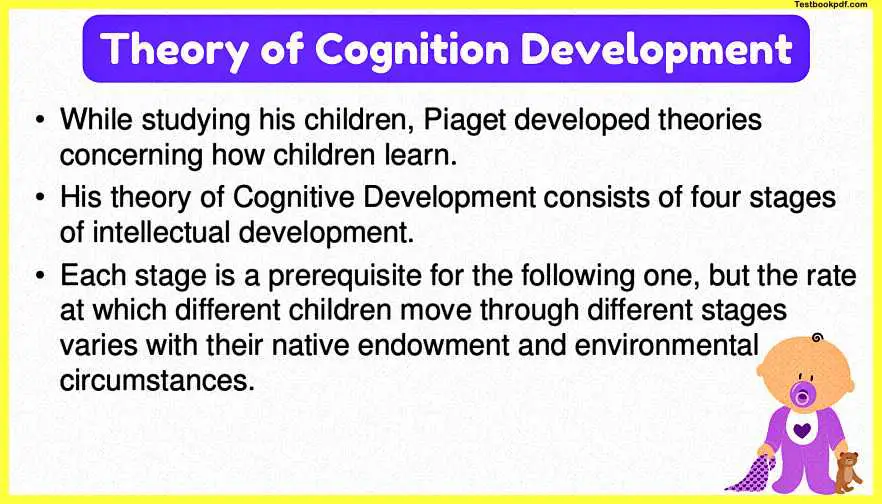
- While studying his children, Piaget developed theories concerning how children learn.
- His theory of Cognitive Development consists of four stages of intellectual development.
- Each stage is a precondition for the one after it, but the speed at which various children advance through them differs depending on their innate abilities and contextual factors.
What is Cognition?
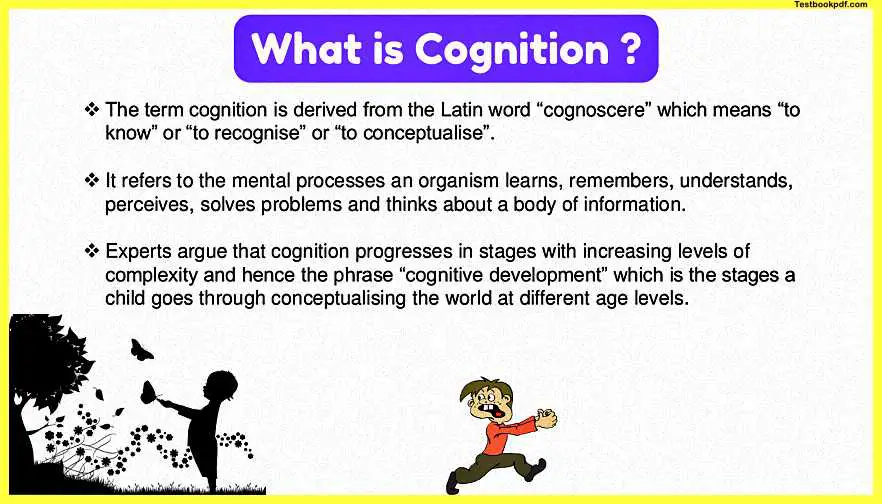
- The Latin word “cognoscere,” which means “to know,” “to recognize,” or “to conceptualize,” is where the word “cognition” comes from.
- It describes the mental procedures through which an organism picks up new knowledge, retains it, comprehends it, observes it, understands how to solve issues, and thinks about it.
- The word “cognitive development,” which refers to the phases a kid goes through conceptualizing the world at various age levels, refers to the stages cognition passes through with increasing levels of complexity, according to experts.
Assimilation
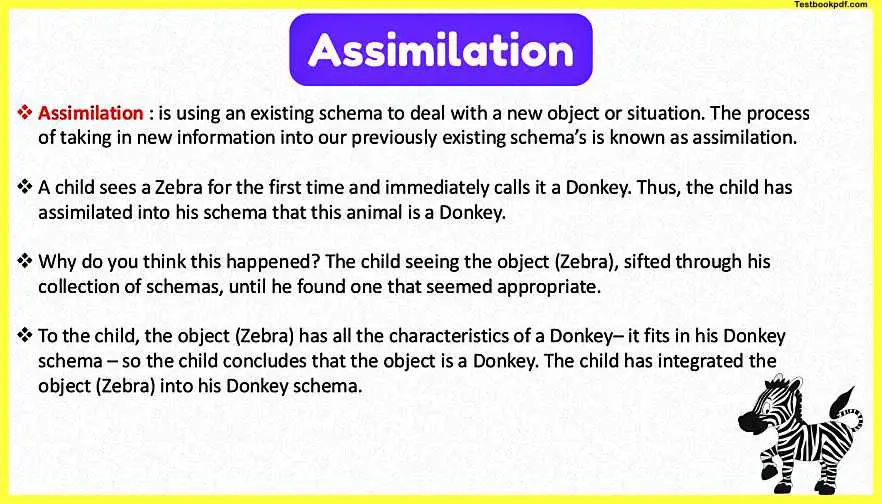
- Assimilation is the process of adapting an existing schema to a fresh object or circumstance. Assimilation is the process of incorporating new information into our preexisting schema.
- When a child first sees a zebra, they mistakenly think it’s a donkey. Thus, the toddler has integrated the idea that this animal is a donkey into his mental model.
- Why do you think this happened? The child seeing the object (Zebra), sifted through his collection of schemas until he found one that seemed appropriate.
- The child assumes that the object (Zebra) is a donkey since it fits his schema of a donkey and has all the qualities of one. The Zebra object has been incorporated into the child’s Donkey schema.
How Cognitive Development Occurs?
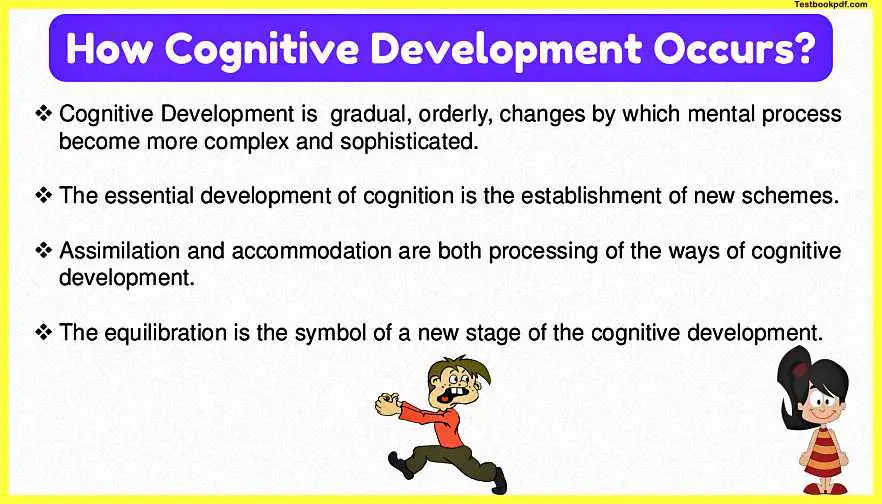
- Cognitive Development is gradual, orderly, changes by which mental processes become more complex and sophisticated.
- The essential development of cognition is the establishment of new schemes.
- Assimilation and accommodation are both processing of the ways of cognitive development.
- The equilibration is the symbol of a new stage of cognitive development.
Schema
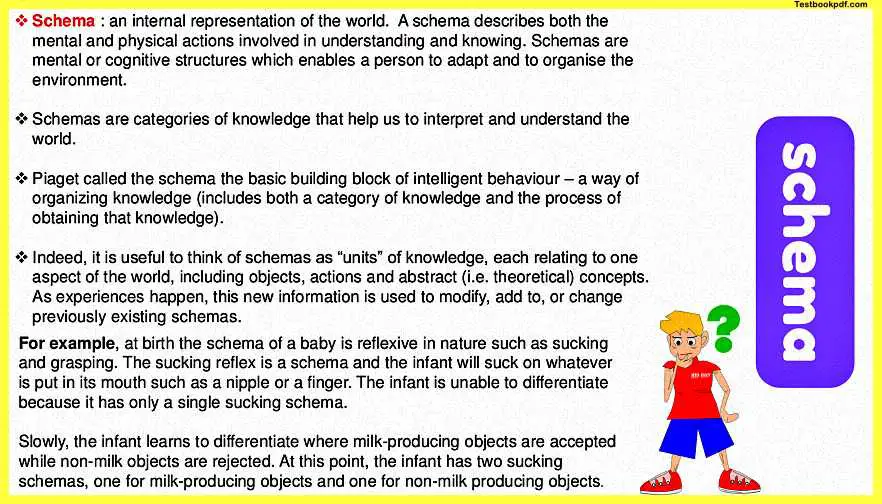
- Schema: a world representation held within. A schema summarizes the mental and physical processes necessary for comprehension and knowledge. A person can adapt to and organize their surroundings using schemas, which are mental or cognitive structures.
- Schemas are categories of knowledge that aid in our interpretation and comprehension of reality.
- The schema, which Piaget described as a system for organizing knowledge, is the fundamental building block of intelligent activity (includes both a category of knowledge and the process of obtaining that knowledge).
- In fact, it is helpful to think of schemas as “units” of knowledge, each referring to a different part of the outside world, such as things, things done, and abstract (i.e. theoretical) concepts. As experiences unfold, this fresh knowledge is applied to alter, supplement, or add to preexisting schemas. For instance, a baby’s schema at birth is reflexive and includes actions like sucking and grasping. The newborn will suck on anything placed in its mouth, such as a finger or nipple because the sucking reflex is a schema. Because it just has one sucking strategy, the child is unable to distinguish between objects. The newborn gradually learns to distinguish between items that produce milk and those that do not, rejecting the latter. The infant currently has two sucking schemas, one for objects that provide milk and one for those that do not.
Equilibration
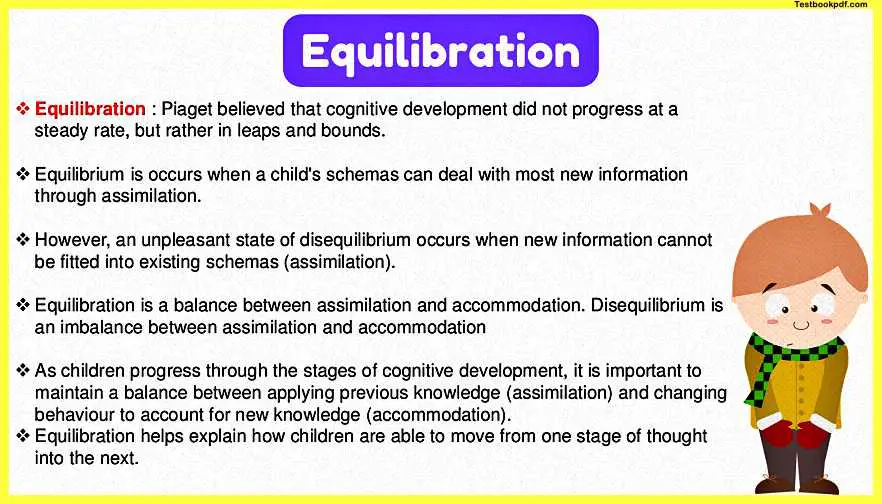
- Equilibrium: Piaget thought that cognitive growth did not advance steadily but rather advanced rapidly.
- When a child’s schemas can assimilate the majority of new information, equilibrium has been reached. However, when new knowledge cannot be incorporated into current schemas, an uncomfortable condition of disequilibrium results (assimilation).
- Assimilation and accommodation are in equilibrium during equilibration. Assimilation and accommodation are out of balance in an unstable situation. It’s crucial to strike a balance as children advance through the phases of cognitive development between assimilation—applying prior knowledge—and adaptation—adjusting behavior (accommodation).
- Equilibration helps to explain how children are able to move from one stage of thought into the next.
Accommodation
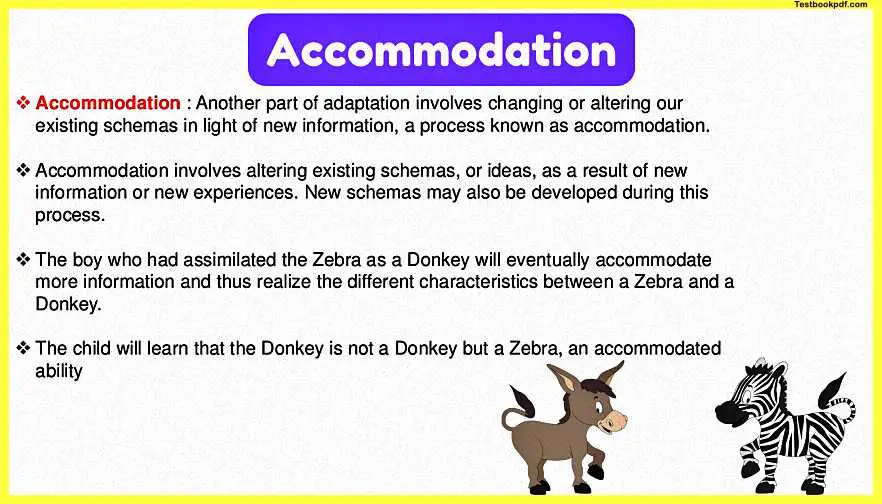
- Accommodation is the process of adjusting or adapting our current schemas in light of new information, which is another aspect of adaptation.
- In order to adjust for new knowledge or experiences, current schemas, or ideas, must be modified. This method may also result in the creation of new schemas.
- The youngster who had mistaken the zebra for a donkey will ultimately take in more knowledge and come to understand the differences between a zebra and a donkey.
- The child will learn that the Donkey is not a Donkey but a Zebra, an accommodated ability.
Adaptation
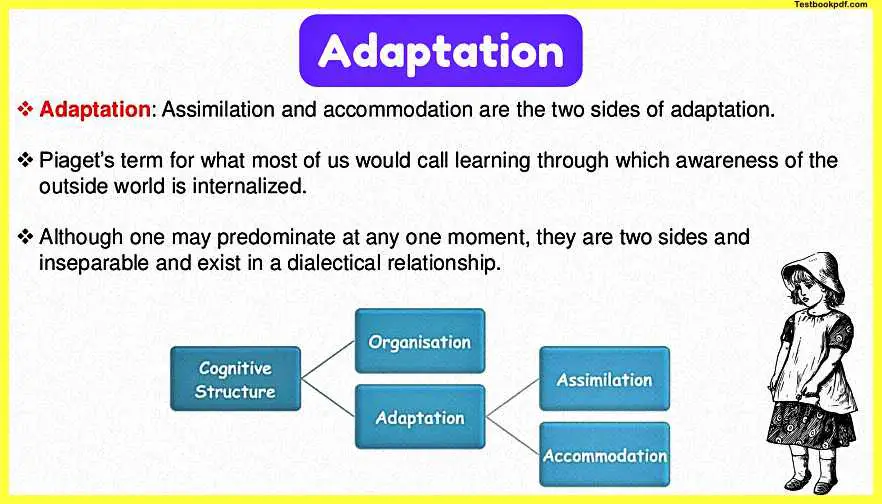
- Adaptation: Assimilation and accommodation are the two sides of adaptation.
- Piaget’s term for what most of us would call learning is through which awareness of the outside world is internalized.
- Although one may predominate at any one moment, they are two sides and inseparable and exist in a dialectical relationship.
Piaget’s Schema Theory Image
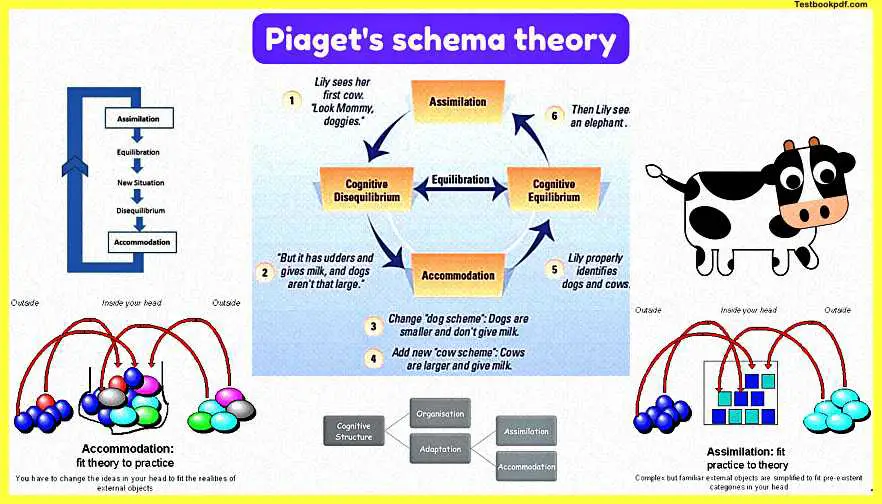
A long time ago
Have you ever heard someone say that their child is like a sponge? Or perhaps comment on how quickly their kid is growing up? These phrases and others like them relate to how children seem to soak up knowledge and change rapidly over their first few years of life. Kids change a lot during childhood, and what happens during this time period can have a lasting impact on their behaviors in adulthood. The field of developmental psychology tries to explain how and why people’s thoughts, feelings, and behaviors change over their lifetime, with a particular emphasis on childhood, since this is when a lot of important changes occur, and these changes predict later adult psychology. Developmental psychology is an enormous topic that would be impossible to cover in a single article.
How do psychologists study development?
Psychologists have a few different techniques to answer different questions. Let’s say you’re interested in the development of morality. How does it change across one’s lifetime, and when does it develop?
Longitudinal Study
To answer the first question, you would want to perform a longitudinal study and follow the same group of people as they grow up. You would take a group of young children, say four-year-olds, and ask them what they think right and wrong mean. Then you would bring them back into the lab every few years, ask them the same questions, and see how their answers change. If you cared less about how morality changes across development and more about when children develop morality, you would probably do a cross-sectional study or an age of onset study.
Cross-sectional Study
For a cross-sectional study, you would take a few groups of kids at different ages and see how their behaviors differ. How does the morality of eight-year-olds differ from that of six-year-olds and from that of four-year-olds?
Age of Onset Study
The age of onset study is similar in that you’re studying different age groups, but in this case, you don’t compare the age groups to each other. Instead, you ask
- what do four-year-olds do in this morality task?
- What about six-year-olds?
- What about eight-year-olds?
Generational Study
let’s pretend you’re interested in how growing up at different times might affect morality. You would do a generational, or cohort, study in this case, and ask how people who grew up in different times thought about morality.
Do boomers have the same ideas about morality as millennials? If not, how are they different?
Now that we have a basic understanding of how developmental psychologists tackle developmental questions.
Nature vs Nurture
let’s talk about a debate you may have heard about nature vs. nurture. This debate is about what has the biggest influence on child development. Is your development constrained by nature, where the genes you possess control your behavior and psychology? Or is your development more influenced by nurture, meaning everything else that could influence your behavior, like learned associations from experience, the social and cultural environment, or your interactions with other people?
Well, the answer is… both! The idea of nature vs. nurture is a false dichotomy. We don’t have to pit nature and nurture against each other.
Development
Development is influenced by both your genes and the environment you’re in. In fact, your environment and social interactions can influence which genes are expressed and how they are expressed, ultimately affecting your behavior. While some behaviors may be more influenced by genetic factors than others, and vice versa, development as a whole is affected significantly by both nature, the genes you have, and nurture, the environment you’re in.
kids
Let’s move on to actually talking about kids and how they develop. An important thing to note is that children are not just really dumb adults. Children occupy a very specific developmental niche. The way they view and interact with the world is inherently different from adults and will change as the child grows and develops. This means that kids think and reason differently than adults and will see the world in different ways. As a child grows, they build up their knowledge about the world through their experiences. They are actively experimenting with the world around them, and from the results, build an understanding of how the world works. To get a framework around this process.
Jean Piaget’s first interests
When Jean Piaget was just 11 years old, he wrote his first scientific study on albino sparrows, reflecting his early interests in animals. He started using standardized intelligence tests in 1920. He realized that younger children consistently make types of mistakes that older children do not. He concluded that they must think differently and spent the rest of his life studying the intellectual development of children.
Piaget’s Stages
we are going to focus on a theory that is commonly used to describe child development known as “Piaget’s Stages.” Jean Piaget was a psychologist in the early 1900s who proposed a theory to describe how children’s intelligence grows and changes. His theory relies on the idea that cognitive abilities build upon one another.

As we go through these stages, we will reference some approximate ages at which children go through a particular stage. Psychologists today generally think that all children go through these stages in this order and on average at these time periods, but there is some variation. Certain kids move through the stages faster than others, and these kids aren’t necessarily ‘smarter’, it’s just some natural variation.
Piaget’s theory argues that we have to conquer four stages of cognitive development.
- The sensorimotor stage.
- The pre-operational stage.
- The concrete operational stage
- The formal operational stage.
Only once we have gone through all the stages, at what age can vary, we are able to reach full human intelligence.
#1. The Sensorimotor stage (0-2)
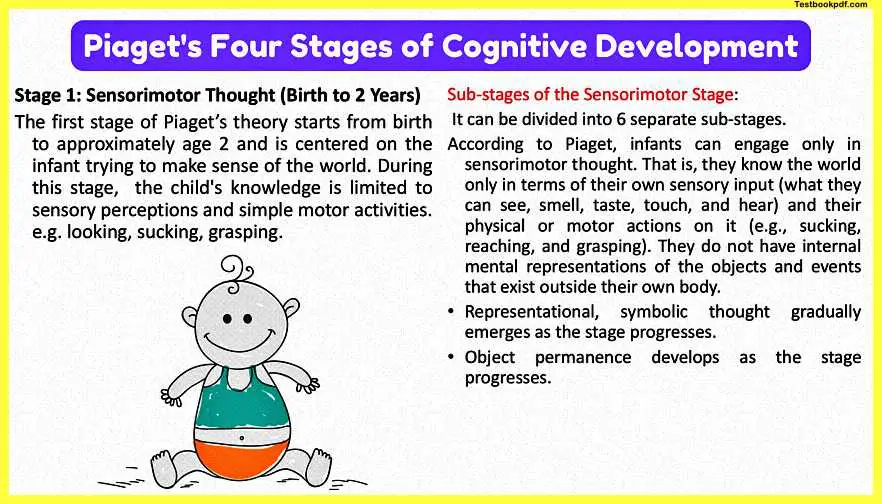
The first stage is called the sensorimotor stage, and this usually occurs between birth and two years old. This stage is characterized by an enormous amount of growth and learning. We all go from being an infant who is lightly interacting with their world through reflexes, to a toddler who is actively moving and exploring. Kids in this stage use the skills and abilities that they are born with, like
- Looking
- Grasping,
- Listening
to explore their environment. They use their senses and motor abilities to learn through trial and error about the world around them. It’s during the sensorimotor stage that children begin to learn that their actions can cause specific reactions.
For example, they might begin to realize that when they shake a rattle, it makes a pleasing sound. Or that pushing a light switch causes a light to turn on or off. They also might try to make different sounds to see if they can get a response from a caregiver. An important cognitive milestone in this stage is the development of object permanence.
During the sensorimotor stage, our five senses move as we learn from experiences. As much as possible, our brain craves the senses of sight, sound, smell, taste, and touch. We begin with basic reflexes, and shortly after that, our first habits emerge. We start to see things outside of our own bodies when we’re four months old, and as we get older, we start to learn how to act consciously. The growth of working memory, or in Piaget’s words, “Our realization of object permanence,” is a significant developmental stage.
Before then, our mother might show us a teddy and then hide it, leading us to believe it had vanished. Once we realize that objects persist even when we cannot see them. We start developing a generalized curiosity. We desire to taste food, smell flowers, hear music, and converse with others. We move, learn to sit, crawl, stand, walk, and even run in order to further our exploration. As a result of our increased physical mobility, our cognitive abilities also grow, but we continue to be egocentric, which means we can only see the world from our own perspective.
Piaget’s Substages of Cognitive Development
- Representational, symbolic thought gradually emerges as the stage progresses.
- Object permanence develops as the stage progresses.
1. Reflexes (0-1 month): Infants’ activities during the first month of life are a reflection of their natural reflexes—automatic reactions to specific stimuli. Sucking, grabbing, and knee-jerking reflexes are examples of inborn reactions that children use to interpret their environment. These are the reflexive abilities that newborns essentially have when they leave the womb.
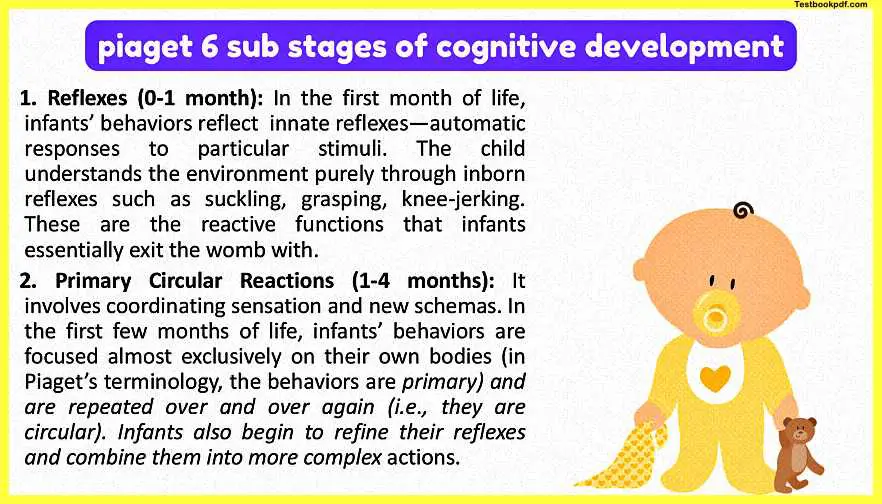
3. Secondary Circular Reactions (4-8 months): In this stage, the child becomes more aware of and more responsive to the outside world (their behaviors become secondary), and they begin to notice that their behaviors can have interesting effects on the objects around them. The child becomes more focused on the world and begins to intentionally repeat an action in order to trigger a response in the environment.

Object Permanence
Very young infants do not have object permanence, that is, they don’t understand that objects continue to exist even when they can’t be seen or heard. This is why young infants will act surprised during a game of peek-a-boo. When you hide behind your hands, the infants believe that you are actually disappearing. Older infants that have developed object permanence will learn and understand that you continue to exist even when they can’t see you.
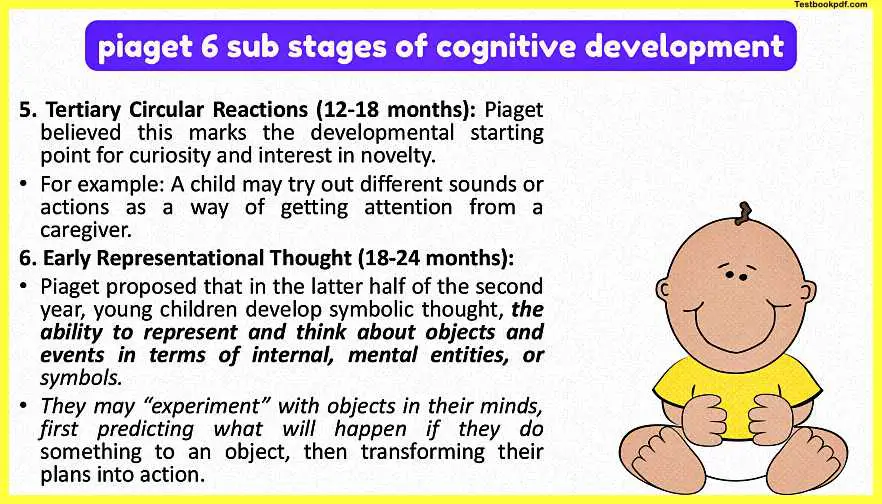
#2. The pre-operational stage (2-7)
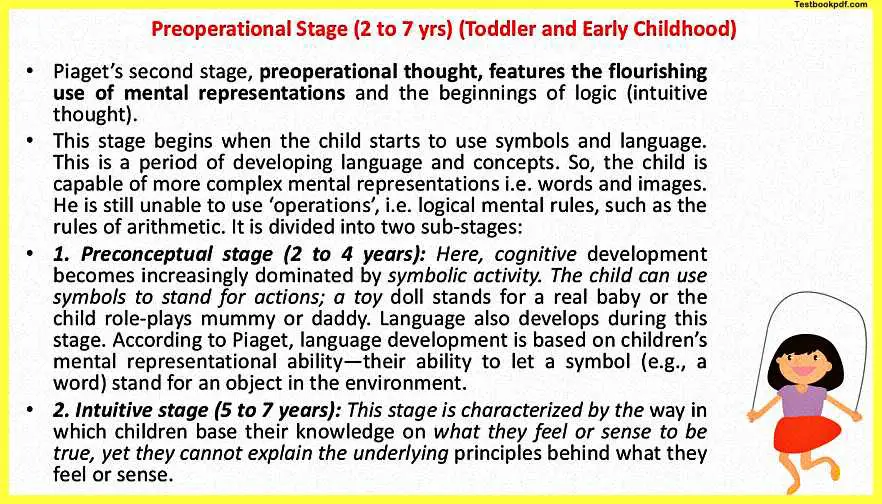
The next stage is the preoperational stage, which happens around two years old to seven years old. In this stage, children become proficient in the language. They also begin to think symbolically, as you know if you’ve ever played pretend with a child. They can use an object to represent something else, like pretending a broom is a horse if they want to be riding a horse. Kids in this stage still struggle with some logical tasks and often struggle with adopting the view of other people. They may think that everyone sees things as they see them. They also struggle with conservation.
For example, say you have two identical containers with equal amounts of liquid. Then you pour the liquid from one container into a differently shaped cup, like a tall, thin cup or a short, wide cup. Even though the amount of liquid did not change, children will say that there is more liquid in whichever cup appears to be fuller.
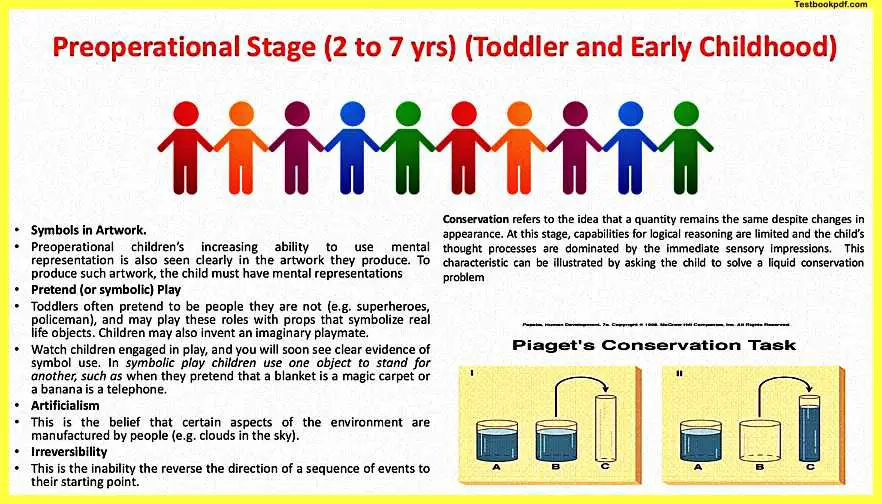
Our thinking is mainly categorized as symbolic functions and intuitive thoughts. We have lots of fantasies and believe objects are alive. As we are not able to apply specific cognitive operations, Piaget calls this stage ‘pre-operational’. As we learn to communicate, we come to grasp that gestures, pictures, and words all serve as symbols. When we draw our family, we are more concerned with their symbolic connotations than withdrawing each member to scale. We enjoy making up stories to explore new things and learn new things. Most of us start to become quite curious and start asking plenty of questions around age 4. We are curious about everything. It might be referred to as the beginning of basic reasoning. Piaget calls it ‘the intuitive age’ because while we realize that we have a vast amount of knowledge, we have no idea how we acquired it. Our thinking in this stage is still pretty egocentric. We think others see the world like we do and still don’t understand that they see it differently.
#3. The concrete operational stage -age is (7-11)
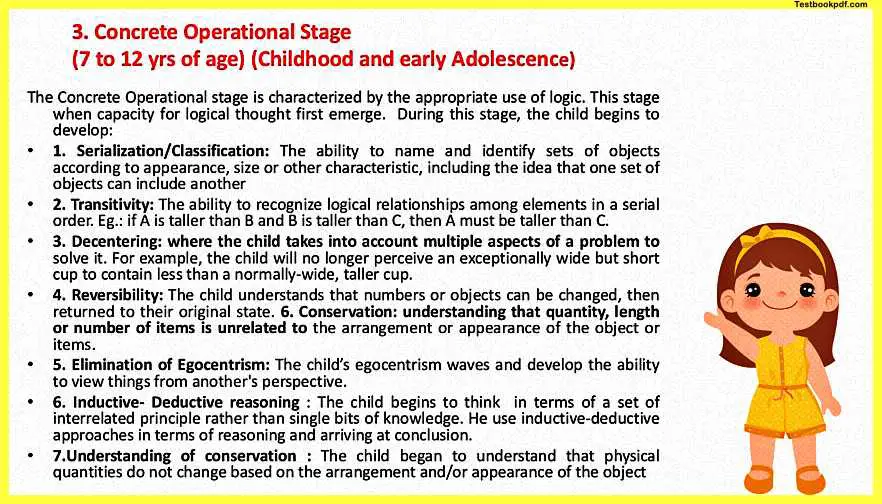
The third stage is the concrete operational stage, which takes place between around seven and eleven years old. Unlike in the previous stage, children now understand conservation. They know that breaking a candy bar into more pieces does not mean there is more candy.
Children in this stage also begin to develop logical thought. Although they still tend to be very concrete in their thinking, children are beginning to excel at certain logical tasks like inductive logic, This means that they can go from a specific experience to a general principle. Say you notice that every time you’re around a cat, you get itchy eyes and a runny nose. Children who have mastered inductive logic would then be able to induce that you are allergic to cats.
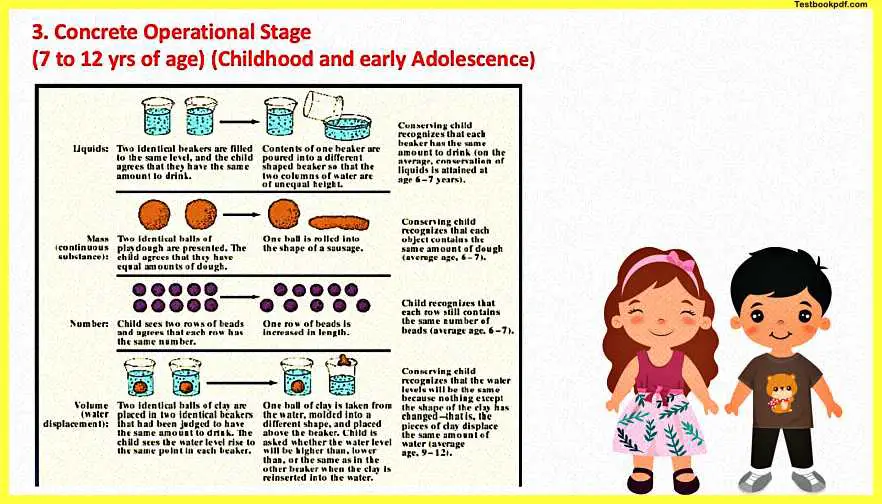
Finally, the logic is revealed, and concrete cognitive functions like item sorting are developed. One illustration of this is inductive reasoning, which allows us to infer a conclusion and then create a generalization to understand the idea of conservation if we observe someone eating a cookie. We are aware that the amount of orange juice remains the same when transferred from regular glass to a taller one. Assuming she will receive more, our younger sister will choose the taller glass. By using the same reasoning, we can now only conclude that if 3 plus 5 = 8, then 8 minus 3 must also equal 5. Our brain develops the ability to reorganize our thoughts in order to categorize and create real, usable mental structures.
For instance, we now understand that we can stop action by taking the opposite action. As we learn to write and engage in other activities, we enthusiastically use our new mental skills. We learn more about ourselves as a result. We start to realize that our thoughts and emotions are special and may not always be shared by others. In other words, we develop the ability to put ourselves in another person’s shoes.
#4. The formal operational stage (12-Above)
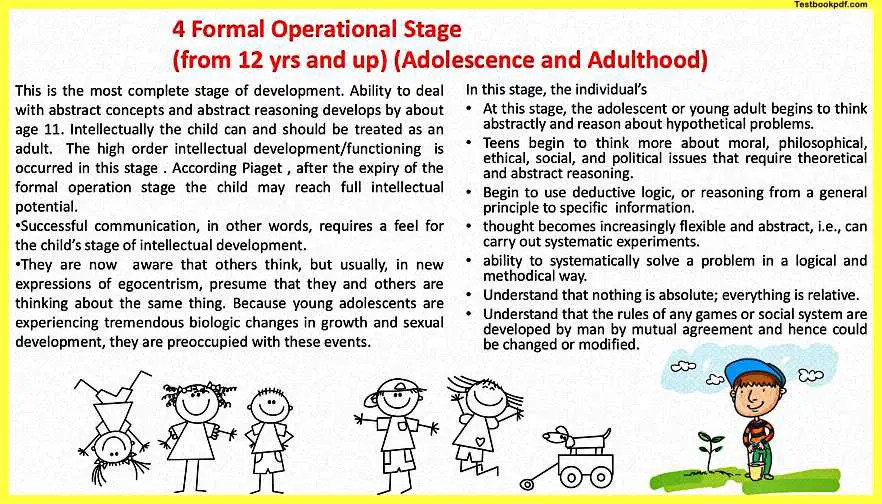
The fourth and final stage of Piaget’s stages is the formal operational stage, occurring when kids are around twelve years old and older. Children and young adults in this stage have the capacity for much more sophisticated thought. They can think about abstract and theoretical concepts and can come up with creative solutions to problems using logic. In this stage, a child doesn’t need actual concrete objects to answer questions via trial and error. Instead, they can perform mental operations in the head using abstract terms.
For example, kids at this stage can work through the following question in their head: “If you imagine something made up of two quantities, and the whole thing remains the same when one quantity is increased, what happens to the second quantity?”
When we reach adolescence, we officially begin to function. We may now consider hypothetical situations and abstract ideas more logically. We are able to comprehend abstract ideas like love and hate, success and failure thanks to our highly developed cognitive faculties. We have a better grasp of who we are and what is right and wrong. We now believe that we know why people act the way they do and may, therefore, develop greater compassion. We may now compare two assertions using deductive reasoning in our brains to arrive at logical generalizations. Our improved mental abilities enable us to prioritize and plan our lives in a systematic manner. We can also make assumptions about future events that are not always true. Now, we can philosophize and simply consider the act of thinking. Now that we have a stronger feeling of who we are, we also have egocentric notions, and some people start to imagine that someone is constantly observing them. Although he argued that the formal operational stage is the last stage of our cognitive development, Piaget was a proponent of lifelong learning.
Practical Application
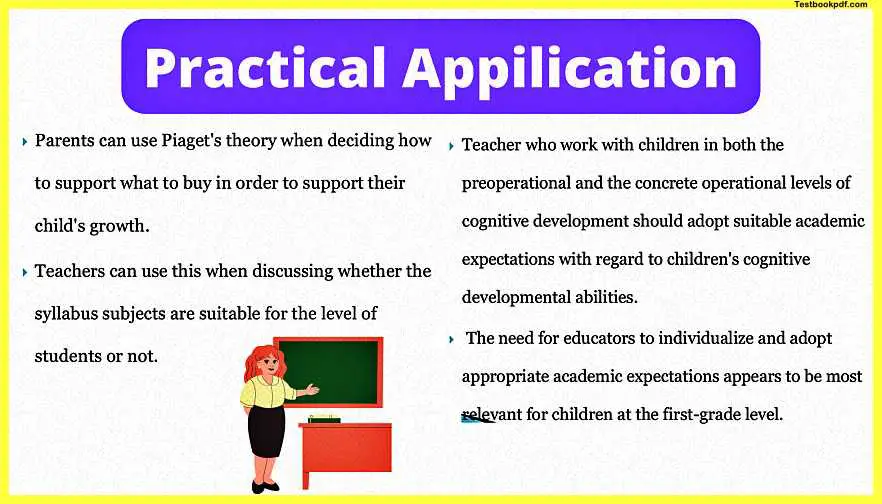
- Parents can use Piaget’s theory when deciding how to support what to buy in order to support their child’s growth.
- Teachers can use this when discussing whether the syllabus subjects are suitable for the level of students or not.
- Teachers who work with children in both the preoperational and the concrete operational levels of cognitive development should adopt suitable academic expectations with regard to children’s cognitive developmental abilities.
- The need for educators to individualize and adopt appropriate academic expectations appear to be the most relevant for children at the first-grade level.
Strengths of Piaget’s Theory
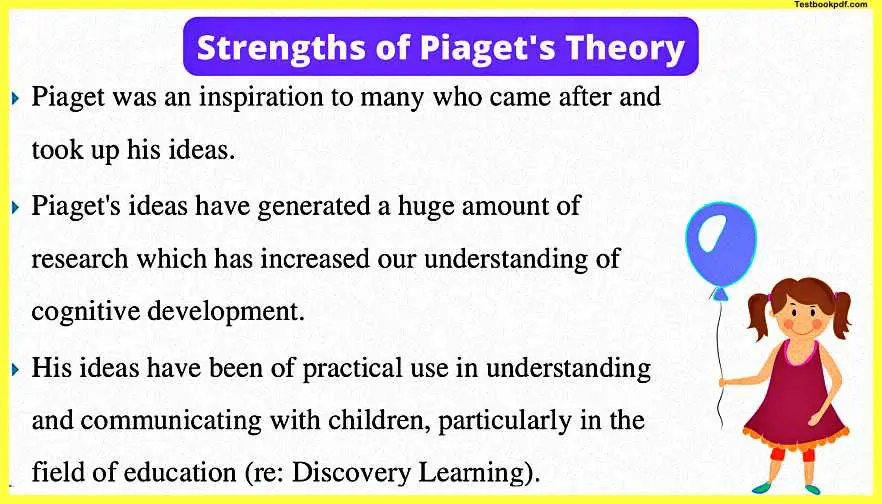
- Many people who came after Piaget was inspired by him and adopted his concepts.
- We now know more about how the brain develops cognitively thanks to the extensive study that Piaget’s theories have inspired.
- His theories have been useful, especially in the realm of education, for comprehending and speaking with children (re: Discovery Learning).
Weakness of Piaget’s Theory
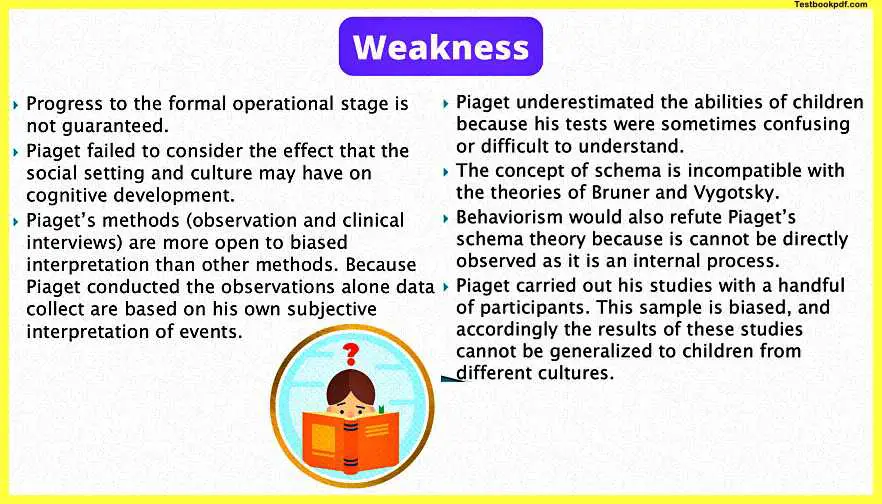
- Progress to the formal operational stage is not guaranteed.
- Piaget failed to consider the effect that the social setting and culture may have on cognitive development.
- Piaget’s methods (observation and clinical interviews) are more open to biased interpretation than other methods. Because Piaget conducted the observations alone data collected are based on his own subjective interpretation of events.
- Piaget undervalued children’s skills since his tests were occasionally unclear or challenging to comprehend.
- Bruner and Vygotsky’s theories are incompatible with the schema concept.
- Piaget’s schema theory would also be challenged by behaviorism because it is an internal process that cannot be immediately witnessed.
- Piaget conducted his research with a small number of subjects. The results of this research cannot be applied to kids from other cultures because this sample is skewed.
Piaget vs Vygotsky table
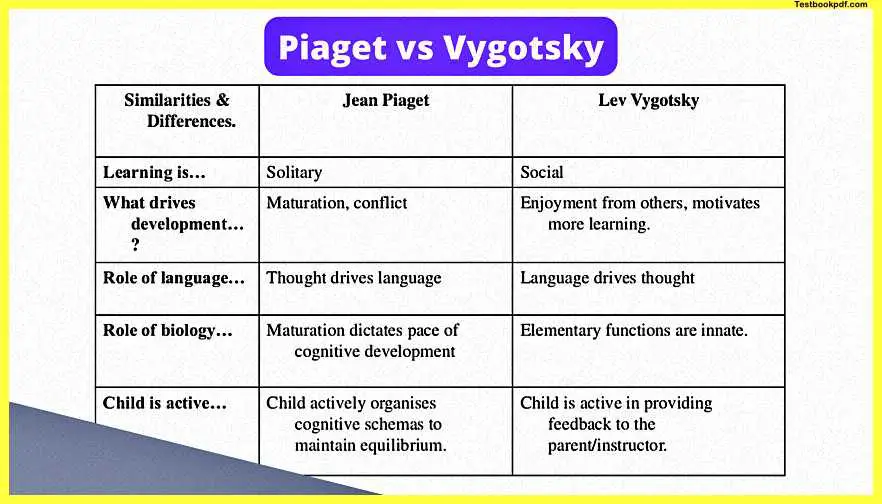
Piaget’s four stages of Cognition Development
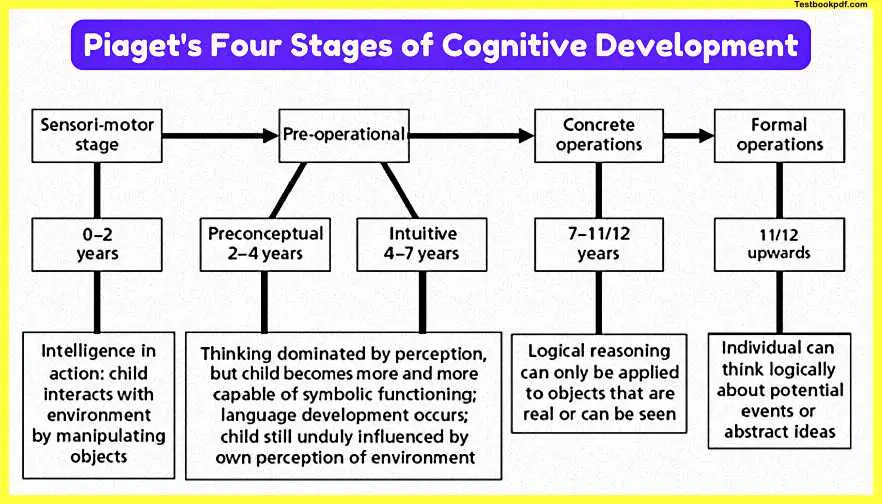
Piaget’s four stages help us understand how children develop cognitively across development. Importantly, Piaget didn’t think that kids develop by simply adding more knowledge to their brains as they grow up. Instead, the quality of how they think changes as they progress through the stages. A seven-year-old thinks differently than they did at age two. Today, psychologists generally appreciate and accept Piaget’s stages, with some caveats. As we mentioned earlier, there is a lot of variation in how children develop. Not all children will move through these stages at the same time. Still, Piaget’s stages provide a useful framework for thinking about child development and they played a huge role in influencing the field of developmental psychology. His theory also helped psychologists realize that kids think differently than adults and that they aren’t just smaller versions of adults.
Thanks for reading this article.
Read also:
Abraham Maslow Hierarchy of Needs Pdf Download
Erik Erikson Stages of Development (8 Stages+Theory+Images)
